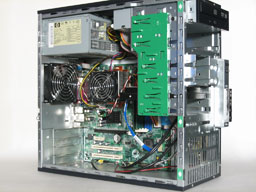
Original Link: https://www.anandtech.com/show/1895
Introduction
We write a lot of articles here at AnandTech about the latest and greatest hardware. Computer enthusiasts like that sort of stuff, but let's be honest: your average person would read one of our articles and probably end up scratching his/her head. More importantly, it's unlikely that a large business is going to read an AnandTech Buyer's Guide or Price Guide and decide to go out and hand-build 150 computers. Doing a cost benefit analysis on that would show it to be a waste of time and money.
That's how OEM companies like Dell, HP, Gateway and others came into being. With their assembly lines and bulk discounts, large OEMs are able to deliver more computers in less time, while still delivering reasonable quality. The standard warranty and support that comes with OEM business computers is also catering to that market. Note that we're not talking about their home computers, which is often a different story.
Just by way of introduction, most of you realize that I already write a lot of our buyer's guides. Outside of AnandTech, I've spent several years working in a large corporation, providing computer, network, phone and technical support. There are over 150 PCs, 15 laptops, and 12 servers. Besides the large IBM mainframe, every one of the computers is from Dell. Are they great computers? Not really, but they also aren't bad, given how they're used. The fact of the matter is that modern PCs are so fast, most home and business users don't even need to buy a high-end system. We have 1.13 GHz Pentium III systems (Dell GX150) that are still more than sufficient for running Windows XP, Word, Excel and browsing the company intranet. Having spent several years supporting Dell desktop computers, I have a pretty good feel for how reliable they are. After three years, the number of failures begins to rise. Of course, after three years, it's probably time to upgrade anyway. That's all part of the business computer market.
When HP offered to send me one of their small to medium business desktops for review, I wasn't entirely sure that the AnandTech readership would appreciate such an article. Hopefully, you won't all think that we've "sold out". Let's make this clear: this system is not meant for the computer enthusiast. It's meant to be reliable, reasonably fast, and easy to set up and use. It's not dirt cheap, but it also includes a legal, preinstalled copy of Windows XP Pro and three full years of next-business-day on-site support. For businesses, those aren't just nice things to have; they are required. The goal of this review is not so much to show how the system performs, but instead to look at the entire package. Is this the sort of PC that you want to use in your business, or perhaps even in your home? Let's find out.
System Specifications
HP's DX5150 comes in a variety of configurations. The base model ships with a 1.8 GHz Sempron 3000+. Yes, these chips do exist for socket 939, but you can only get them in OEM systems - and you can go all the way up to an Athlon 64 X2 3800+ or 4000+. HP elected not to send us the base model, so we have an upgraded hard drive, DVD burner, processor, and memory. Here are the detailed specs for our configuration.
| HP DX5150 Specifications | |
| Motherboard: | HP DX5150 (ATI Xpress 200 chipset) |
| Processor: | AMD Athlon 64 4000+ (ClawHammer) |
| RAM: | 2 x 512MB Samsung PC3200 (3-3-3-8-2T) |
| Hard Drive: | Samsung 160GB SP1614C SATA |
| Graphics: | ATI Xpress 200 IGP |
| Optical Drive: | 16X DVD+/-RW Dual-Layer (GWA-4161B) |
| Audio: | AC'97 Realtek (AL655) |
| Power Suply: | 250W HP-2567F3P 2 X SATA Power 2 X 4-pin MOLEX 1 X Floppy MOLEX 1 X 24-pin ATX 1 X 4-pin ATX12V) |
| Front Ports: | 2 X USB2.0 2 X 3.5mm Audio |
| Rear Ports: | 6 X USB2.0 3 X 3.5mm Audio PS/2 Keyboard and Mouse LAN (GbE) 1 X VGA and 1 X DVI-D 1 X Serial and 1 X Parallel |
| Operating System(s): | Windows XP Professional SP2 |
It should come as no surprise that this system has integrated graphics; nearly every business computer in the world does. Using the ATI Radeon Xpress 200 chipset, this is actually one of the fastest IGP solutions available. When the DX5150 was first created, the Xpress 200 was, in fact, the fastest IGP chipset. One of the good things about this chipset is that it has full support for DVI ports, and the motherboard in the HP system includes both VGA and DVI ports. In our opinion, providing a DVI port is critical for business computers. (Most modern chipset supports DVI ports, but there are still many computers that don't come with such support.) Very few businesses are going to want to use an old CRT these days, and you get the best results by plugging an LCD into a DVI port. As mentioned in our recent TV tuner review, the DVI port can also be used to connect this computer to an HDTV.
One sort of interesting side note is that the internal speaker in the HP system can actually function as a mono sound output. Full 5.1 audio is supported with speakers, but that will almost never be used in the business environment. For the times when you need to play a quick audio file, watch a video, or perhaps just so that you hear the Windows sound alerts, the front mounted speaker will suffice. It even works for games, although 1D audio isn't very impressive.
The remainder of the system is fairly high end. An Athlon 64 4000+, 2x512 MB of RAM, a 16X dual layer DVD burner, and a 160 GB hard drive round out the package. The only change that we would make today is to use an X2 3800+ processor, which would only cost a few dollars more. This is where things get somewhat confusing.
If you go to HP and custom configure this exact system, it will come out to around $1500, not including a monitor. That may seem like a lot, but there's a catch: this particular build is one of HP's "Smart Buys". What that means is that thousands of computers are built with the exact same setup, and the lack of customization options allows HP to build them for less. It's $1500 to take the base DX5150 and turn it into our review system, but the same system is only $1169 as a Smart Buy. It's important to note that this is not a sale or a special offer; this is a standard configuration. While the current Smart Buy for this system ends at the end of this month, it will almost certainly be replaced with an equivalent or better offer. (We want to see the DX5150 with some higher-end components and the additional X2 processors added as Smart Buys!)
For comparison, we configured a similar system at Dell. A Dell OptiPlex GX620 with the Pentium D 840 (3.2 GHz) and similar specs on the other parts roughly equals a custom configured HP on price. Dell doesn't have a direct Smart Buy equivalent, but they often have short-term sales that will more or less equal the price of the HP Smart Buys. Overall, the Dell and HP systems end up being very comparable in price and performance; the AMD chip in the HP will win in certain areas, and the Intel chip in the Dell will win in other areas, so it mostly comes down to personal preference. Getting an X2 HP system, though, would of course make it faster than almost any Intel Pentium D configuration from Dell.
As we mentioned, the bundled copy of Windows XP Pro and a three-year warranty contribute to the cost. However, it's Christmas, so many OEMs are offering sales on similar systems. Regardless, with the included software and the standard three-year warranty, the prices are very competitive with what you could build on your own. The only thing missing from these systems are options like overclocking support, but that's not surprising.
| AMD Custom System | ||
| Hardware | Component | Price |
| Processor | Athlon 64 4000+ 2.40 GHz 1MB (939) - Retail | $334 |
| Motherboard | ASUS nForce 430 GeForce 6150 (939) A8N-VM CSM | $88 |
| Memory | Crucial Ballistix 2x512MB (2-2-2-6-1T) | $119 |
| Video Card | Integrated GeForce 6150 | $0 |
| Hard Drive | Hitachi SATA 250GB Deskstar T7K250 3.0 Gbps | $108 |
| Optical Drive | NEC 3550A DVD+RW | $42 |
| Case and Power Supply | COOLER MASTER Centurion 540 with 380W PSU | $69 |
| Keyboard and Mouse | Logitech Internet Pro Desktop | $16 |
| Operating System | Windows XP Professional SP2 | $142 |
| Shipping | 3 day UPS (varies by location) | $37 |
| Warranty | Two year extended warranty - offsite RMA | $175 |
| Bottom Line | $1130 | |
As a second comparison, we put together a similarly equipped custom-built system. As you can see from the price rundown, it's only slightly cheaper to build a PC yourself, and potentially slightly more expensive. It's going to be a more flexible route, but it also requires more time and effort. We used the Newegg extended warranty prices for comparison, but you only get limited onsite support (for large/bulky items); otherwise, you have to take the part to an authorized Service Net dealer. It's also only a two-year extended warranty. Relative to a custom-built system, then, you're getting a better warranty for a slightly higher price with the HP desktop, at the expense of enthusiast features. This is exactly what will interest businesses: stability, homogeneity, and service at a lower TCO (Total Cost of Ownership).
One final note regarding the DX5150 is that it is available in two different form factors. We are reviewing the mini-tower version, but the desktop version is also available. The desktop system is slightly smaller, and there isn't as much room for expansion. I personally prefer the tower, but many businesses might find the desktop to be the better option. It allows you to tuck the computer underneath the monitor, potentially raising the monitor to a high level while conserving desk space at the same time. However, we would be hesitant to try stuffing a high-end graphics card into the desktop design, since it doesn't have the extra case fan.
Installation and Setup
It should come as little surprise that installing this computer is extremely simple. I don't know if my mother could do it, but just about anyone else in the family would have no difficulty. You unpack the box, plug in the keyboard, mouse, LAN and power connectors, connect a display, and power up the system. At that point, you'll be prompted for the Windows product key. A quick reboot, go through the activation wizard, and you're done. The total time required to unpack the system and get it up and running is less than 30 minutes, and most of that is spent arranging the parts on the desk.
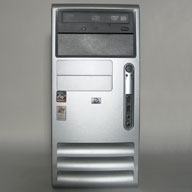 |
 |
| Click on images to enlarge. | |
One of the nice things about this system is that, unlike many home computer systems from large OEMs, you don't get a ton of useless preinstalled software. (Businesses usually don't like that stuff, and they often have their own set of programs that they use.) HP includes some diagnostics utilities, some documentation, and drivers for all the installed hardware. You might find one or two pieces of software that you want to uninstall, but thankfully, there's no spyware or other junk software. While it costs extra, one piece of software that most companies will want to get is Microsoft Office 2003. You can get the Basic, Small Business or Professional editions for $99, $219 or $299, respectively. That's slightly less than what most places charge for the OEM versions.
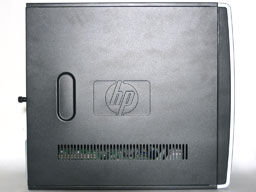 |
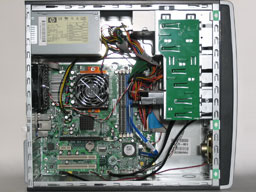 |
| Click on images to enlarge. | |
Being computer geeks, we naturally had to "pop the hood". The left side of the case is secured by a single thumbscrew, and after loosening that, it slides off. It can take a bit of effort at times, but it isn't too difficult, and the panel can be secured by a lock if desired. The internal layout of the system is clean, and there are several areas that provide for future upgrades. Available expansion options include one PCIe X16, one PCIe X1 slot, and two PCI slots; there are one free 5.25" and two 3.5" external bays - unless you choose to get a floppy drive - and there is also room for a second internal hard drive.
Most of the case features are very easy to work with. Three plastic tabs secure the front bezel, and pressing them in allows you to pull that off. That exposes all of the drive bays. The drive bays have a quick release mechanism located on the left side of the case, and the DVD and hard drive come preinstalled with bolts that serve as rails of sorts. If you need to remove a drive, lift the plastic tab, slide the drive out, and in the process, disconnect the cables from the rear of the drive. Reverse the process to install a new drive. It's extremely simple to do, and you could swap a drive in less than five minutes.
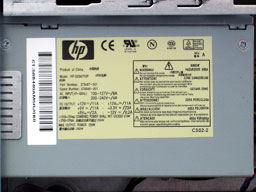 |
 |
| Click on images to enlarge. | |
The power supply is a 250W model, which is on the low end of the spectrum. However, a conservatively rated 250W power supply may actually be equal to an aggressively rated 400W PSU. We didn't encounter any problems when we loaded up the system with a high-end graphics card and a couple of TV tuners, and of course, the onsite warranty means that you're covered if problems do develop.
The expansion slots are one of the few areas that require an actual tool: either a flathead screwdriver or a Torx bit. A single screw secures a plate that locks the four expansion slot brackets in place. After removing the screw, you slide out the plate and then you can access the expansion slots. Overall, the system is clearly designed for businesses: easy to open, maintain, and repair. A small IT staff could easily support several hundred of these systems, which is exactly what most corporations do.
Benchmark Setup
Readers always want to know how a system performs, so naturally, we ran some benchmarks. Let us preface the benchmark segment by simply saying that this is not the most important aspect of this system. There are very few tasks that really need this much computing power, and those that do will probably need a better graphics card. If you're running Word and other office applications, the biggest bottleneck is going to be user input.
That said, we ran several configurations of the HP system through some benchmarks, and we compared the results with a similar custom built system. We expect the custom system to come out ahead by a slight margin, but its purpose is more to show that the HP doesn't have any serious issues. Here are the system specifications for both HP and the custom system.
| HP DX5150 Configuration | |
| Motherboard: | HP DX5150 (ATI Xpress 200 chipset) |
| Processor: | AMD Athlon 64 4000+ (ClawHammer) |
| RAM: | 2 x 512MB Samsung PC3200 (3-3-3-8-1T) |
| Hard Drive: | Samsung 160GB SP1614C SATA |
| Video Cards: | Xpress 200 IGP Gigabyte GeForce 6600 PowerColor X800 Pro PCIe VIVO XFX GeForce 7800 GTX 256MB (450/1250 clocks) |
| Chipset/Video Drivers: | ATI Catalyst 5.12 IGP CCC ATI Catalyst 5.11 CCC NVIDIA ForceWare 81.95 |
| Operating System: | Windows XP Professional SP2 |
| Custom System Configuration | |
| Motherboard: | ASUS A8N-VM CSM (NVIDIA 6150 plus 430 chipset) |
| Processor: | AMD Athlon 64 3800+ (Venice) |
| RAM: | 2 x 512MB OCZ PC4800 EL Platinum (2-2-2-7-1T DDR400) |
| Hard Drive: | Hitachi 250GB T7K250 SATA-2 |
| Chipset Drivers: | NVIDIA nForce4 AMD 6.70 |
| Video Cards: | GeForce 6150 IGP Gigabyte GeForce 6600 PowerColor X800 Pro PCIe VIVO XFX GeForce 7800 GTX 256MB (450/1250 clocks) |
| Video Drivers: | nForce4 430/410 8.22 ATI Catalyst 5.11 CCC NVIDIA ForceWare 81.95 |
| Power Supply: | Thermaltake Silent PurePower W0031 ATX 410W |
| Operating System(s): | Windows XP Professional SP2 |
As you can see, besides the change in motherboard, we also used CL2 RAM. Almost no one who purchases their own memory is going to buy CL3 RAM. HP could easily have installed CL2 instead of CL3 RAM, but reliability and cost savings are the name of the game, and CL3 memory will rarely cause instabilities. (At least their command rate is still 1T.) This is not intended to be an apples-to-apples comparison, and we used an Athlon 64 3800+ Venice core in our comparison system. As we mentioned before, we think upgrading to an X2 processor would be a good idea - for either configuration. You can get an X2 3800+ system as a Smart Buy for less money, though the HDD and optical drive are unfortunately downgraded in the process.
One area that is clearly lacking is the graphics card department. Even if you choose to pay the extra money to customize the system (Smart Buys don't allow customization of the components), you can only select an X300SE with 64MB or 128MB. Both are only slightly faster than the Xpress 200 IGP, and the cost is more than what we would pay for such anemic hardware. To test how the DX5150 performs as a family (gaming) system, we installed three different graphics cards to show what's really possible.
First, we have a stock GeForce 6600 card from Gigabyte, which can be had for $100 and will easily outperform the IGP or either X300SE. Moving to the $200 range, we have an X800 Pro 256MB (which is relatively similar in performance to the X800 XL and GTO cards, though the GTO will often overclock better). Finally, we used an XFX 7800 GTX 256MB, which most buyers of the HP business systems would never even consider. This was mostly used to highlight the system bottleneck (slower RAM and a tuned for stability BIOS), as well as to verify that the 250W PSU could handle such a card. The benefit is that you get to see how two "moderate" systems perform in a variety of benchmarks - we frequently see requests for such benchmarks from our readers.
The charts are colored according to which graphics card is in use. To be fair, you should only compare similarly colored results. We ran most benchmarks on every configuration, but there are a few cases where the graphics card has absolutely no impact on performance.
General Application Benchmarks
We'll start with overall system performance, represented by Winstones 2004 and PCMark04/05. While it won't show up in these benchmarks, it's worth noting that Winstones is almost entirely single-threaded in nature. (Though they provide a Business Multitasking benchmark, this was not included in our testing.) PCMark04 and 05 have several multitasking scenarios along with the single-threaded benchmarks, so a dual-core or HyperThreading processor can be a benefit. All of these serve as reasonable estimates of system performance.
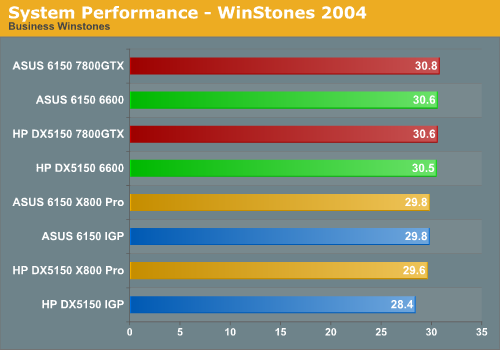
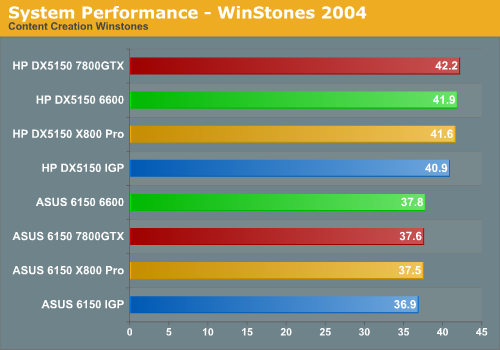
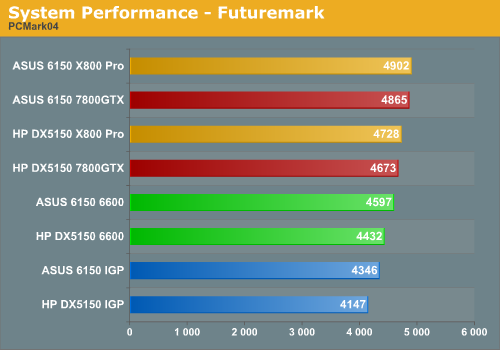
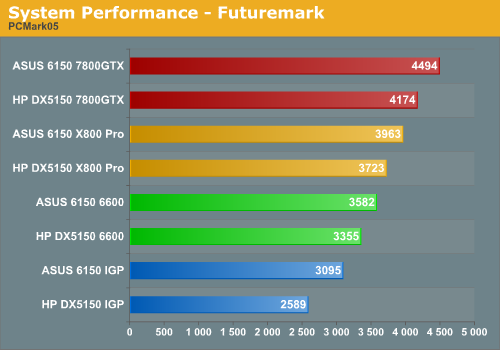
Where the HP wins in the Content Creation scenario, the custom system sweeps the PCMark04/05 results. Also note that both PCMark suites include some 3D rendering, so they do get a boost from faster graphics cards. Unless you will use the 3D capabilities, we wouldn't worry much about the drop in scores that PCMark shows. It may become necessary to install a faster GPU once Windows Vista ships, but that's still nine months away, so we will worry about such things when the OS actually becomes available.
Multimedia and Networking Benchmarks
We ran all the configurations through a set of encoding benchmarks. We used chapter 9 from The Sum of All Fears, with a target quality of 75% and without audio. This does a single-pass encode that results in reasonable quality at the cost of file size. We also ran a multi-pass encode of a 30-second commercial, with a target size of 5 MB and with audio. The original video is 30 MB in size, and AutoGK makes three passes: a compression test, an initial pass, and the final pass. For larger files, the compression test scans segments of the video, so it isn't a full pass. With this small file, it ends up simply doing three full passes.
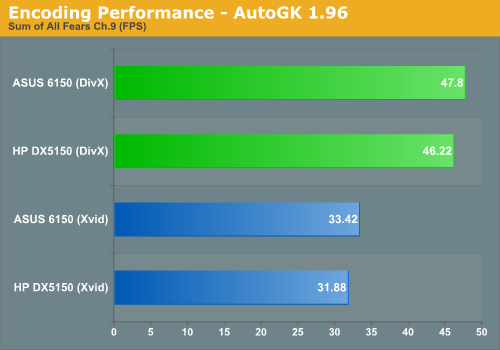
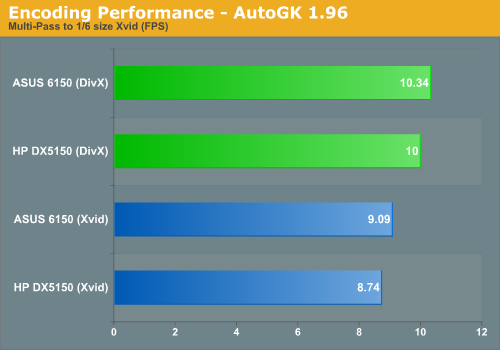
As with encoding performance, using a different graphics card has no impact on network performance. We employed our standard testing methodology using the Windows 2000 DDK. A second system, an MSI K8N Neo Platinum with a 3400+ processor, was set to communicate with each system in turn. Traffic was routed through a gigabit Ethernet switch, but that doesn't matter in real world performance scenarios - rarely does sustained network traffic exceed 500 Mb per second.
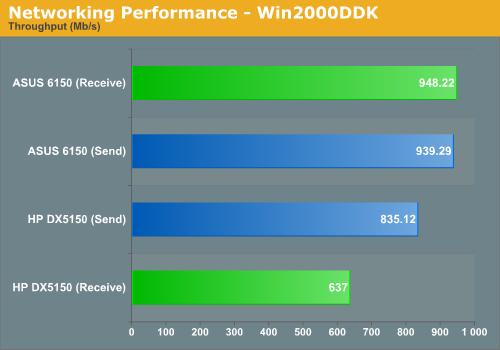
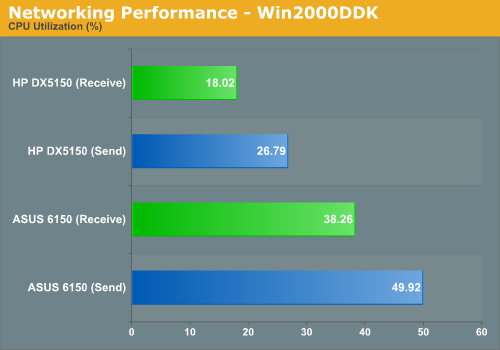
Gaming Benchmarks - Battlefield 2
For our gaming benchmarks, we ran the systems in two different modes: a lower quality mode that allowed the IGPs to get relatively playable frame rates, and a higher quality mode that was a more realistic setting for the discrete graphics cards. Most of the discrete graphics cards will be system/CPU limited in the low quality mode, but that information can be interesting as well. Obviously, the IGP solutions really aren't intended for serious gamers, but we wanted to see if they could still provide a playable gaming experience with lower detail settings.
 |
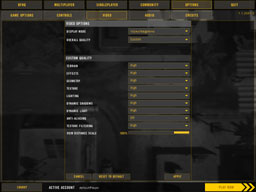 |
| Click on images to enlarge. | |
The above screenshots show the settings that we used in Battlefield 2. Our low quality BF2 configuration uses the "Low" preset, with texture quality also downgraded to low. Anisotropic filtering and antialiasing are disabled, and we tested at 640x480, 800x600, 1024x768, and 1280x1024. (We don't consider 640x480 playable in BF2, as the text is unreadable, but it was included for reference.) The higher quality mode uses the "High" preset, with textures also set to high. Antialiasing is disabled, and anisotropic filtering is set to 8x. The 7800 GTX generally wouldn't have a problem with 4xAA on the tested resolutions, but realistically, we don't expect users to put a 7800 GTX in this type of system.
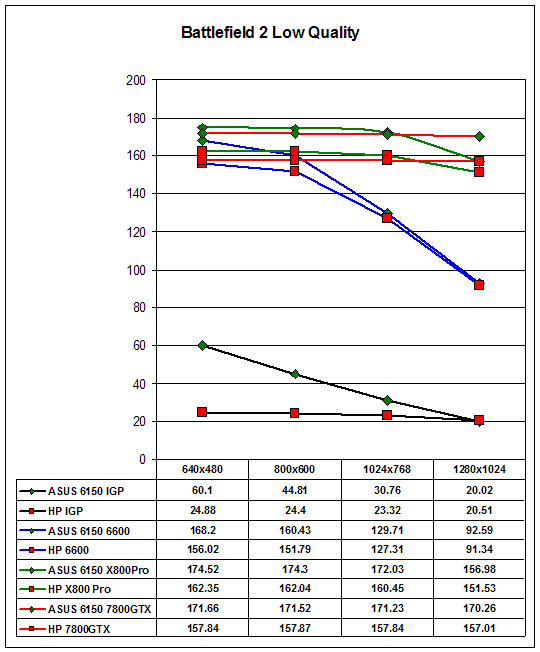
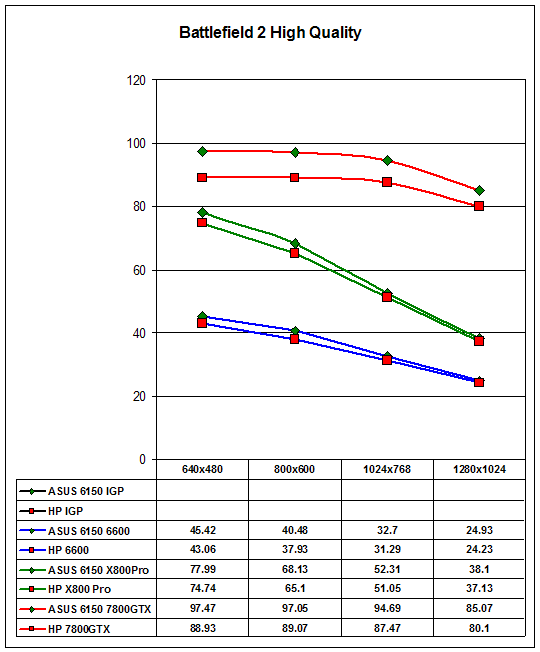
While the integrated graphics solutions struggle to maintain playable frame rates even at the lowest resolutions, sticking with low detail levels and switching to even a 6600 provides very good results. In fact, the 6600 is capable of running very well in the medium quality modes while still maintaining reasonable frame rates. With the more powerful graphics cards, we can see that the faster memory and lower latencies provided on our custom system end up winning out - even with the slower processor. The 3800+ Venice core is limited to 171 FPS, while the HP system is limited to 157 FPS.
Moving onto the higher-quality mode, the IGP solutions are way too slow. Both systems were providing single digit frame rates, so we halted benchmarking rather than waiting for each test to complete. With the other graphics cards, the custom system ends up leading by as much as 9%, but you really wouldn't notice the difference in practical use. It appears that the improved memory controller and cache subsystem on the Venice core makes up for the lack of cache relative to the ClawHammer core. At that point, the lower latency RAM takes the lead.
Gaming Benchmarks - Doom 3
As with BF2, we chose to test in two different settings. We selected the low-quality mode and high-quality modes and benchmarked them at varying resolutions. You can see the settings used in the following images.
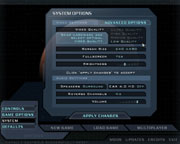 |
 |
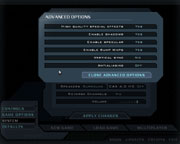 |
| Click on images to enlarge. | ||
Without disabling some of the advanced options, Doom 3 is still very taxing on low end graphics cards. For the discrete graphics cards where we tested both modes, the difference between the low and high settings is at most 10% - at least until we enable antialiasing. Antialiasing puts a larger strain on the GPU memory subsystem, allowing the high-end cards to flex their muscle. Here are the results:
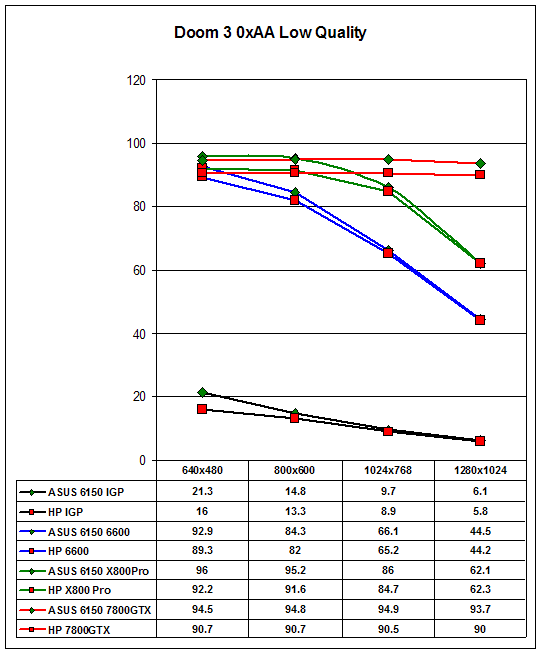
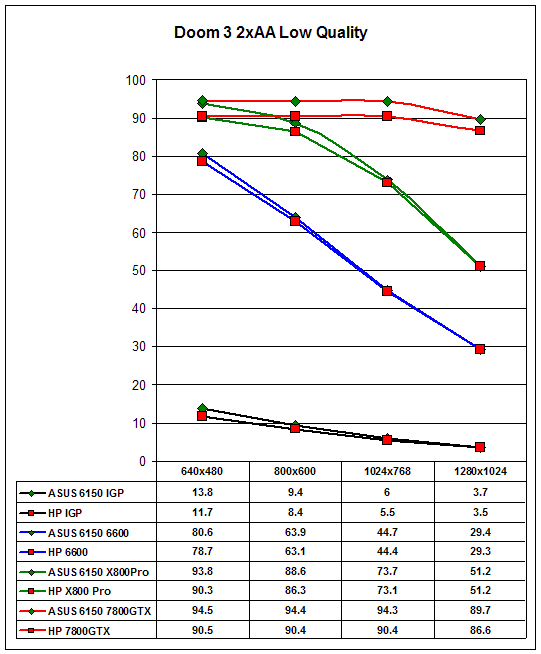
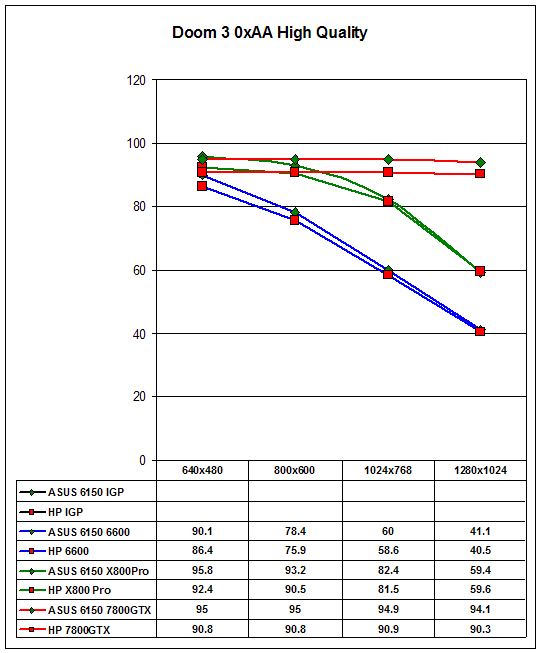
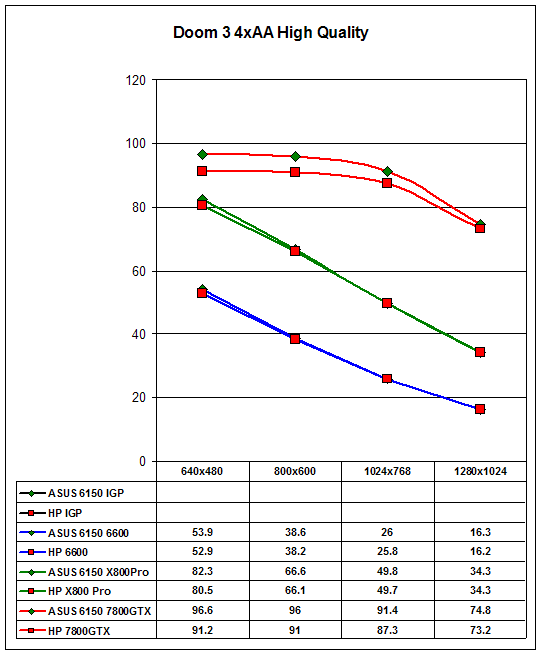
Shifting to the high-quality mode, scores are mostly within 5% of each other. The custom system once again leads by about 6% - at best - but at reasonable resolutions with anything other than the 7800 GTX, it's close enough that we wouldn't worry too much about the loss of performance.
While we didn't include scores here, Quake 4 is pretty much the same story as Doom 3. You really need at least some form of discrete graphics before you can play either game. This appears to be due to the Doom 3 engine's desire for lots of bandwidth. Since both of these platforms share system memory bandwidth between the graphics and the processor, the net result of around 3.2 GB per second is insufficient.
Gaming Benchmarks - Far Cry
Far Cry is the next game that we tested, and the trends that we've seen emerging continue. First, here are the settings that we used in our testing.
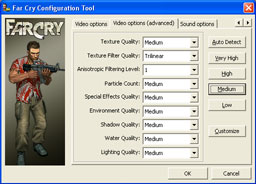 |
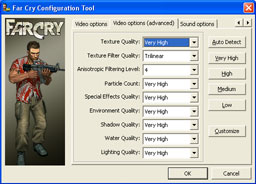 |
| Click on images to enlarge. | |
We initially guessed that the medium quality graphics mode would be playable on the IGP chipsets. In retrospect, we should have dropped to low quality. Being that neither is truly a gaming solution, we left it alone and ran the benchmarks. Incidentally, even a medium quality graphics mode in Far Cry still looks quite nice.
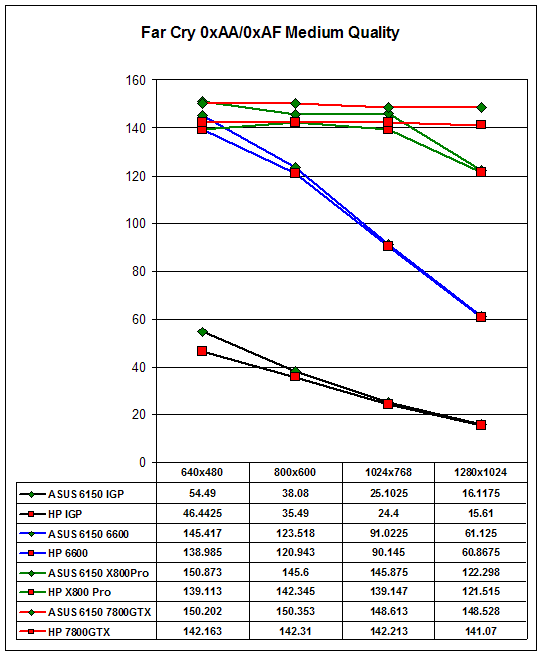
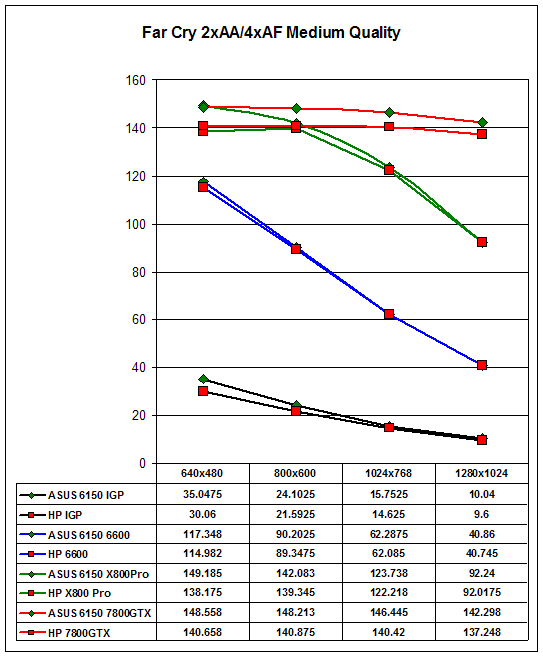
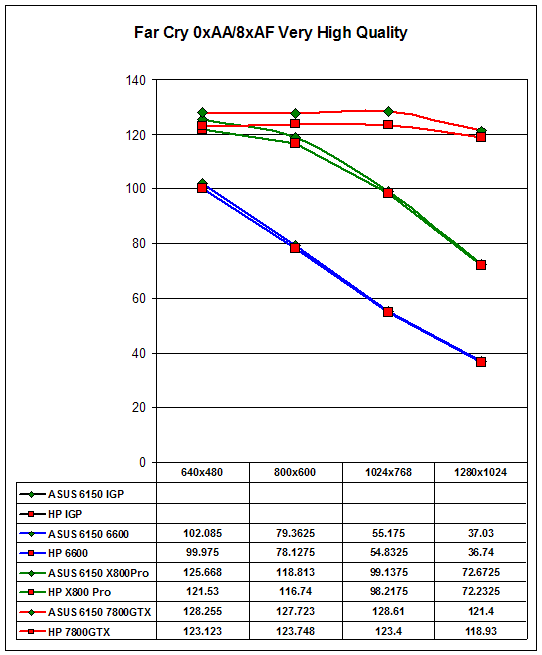
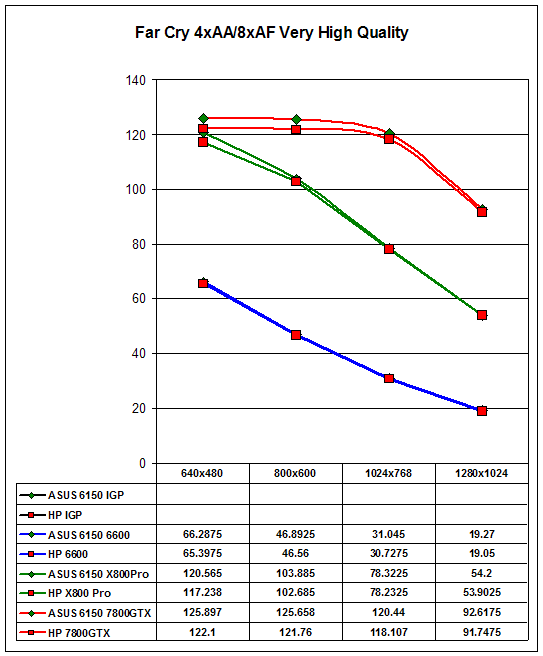
Far Cry shows much less of a difference between the HP system and the custom system. In most cases, it's less than 1%, with the largest gap being about 4%. Obviously, we're not doing an apples-to-apples comparison, but for the vast majority of people, either of these systems will work well in gaming - as long as you add an appropriate graphics card.
Gaming Benchmarks - Half-Life 2
We come to the last of our gaming benchmarks, and again, here you can see the settings we tested.
 |
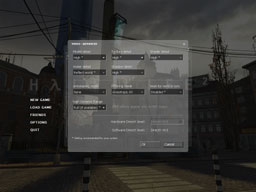 |
| Click on images to enlarge. | |
The Half-life 2 engine is quite a bit more forgiving towards the IGPs. You're not going to get both high-quality and high resolutions out of them, but they do a bit better than in the other games. As with Far Cry, we probably could have had 1024x768 to be playable with the IGPs by dropping texture quality to low.
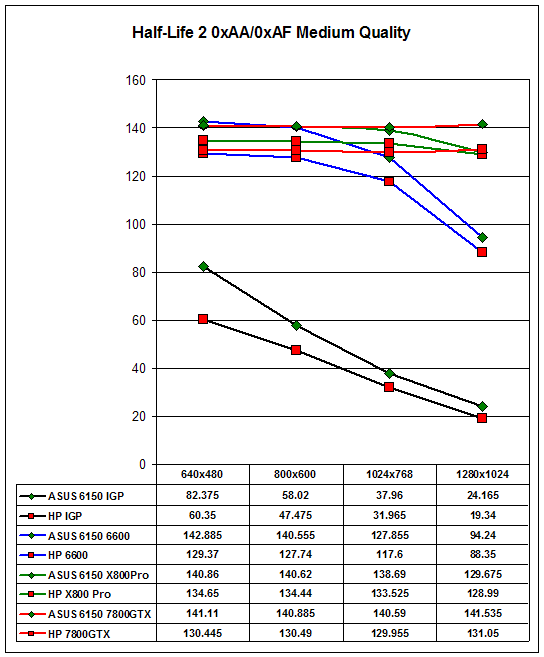
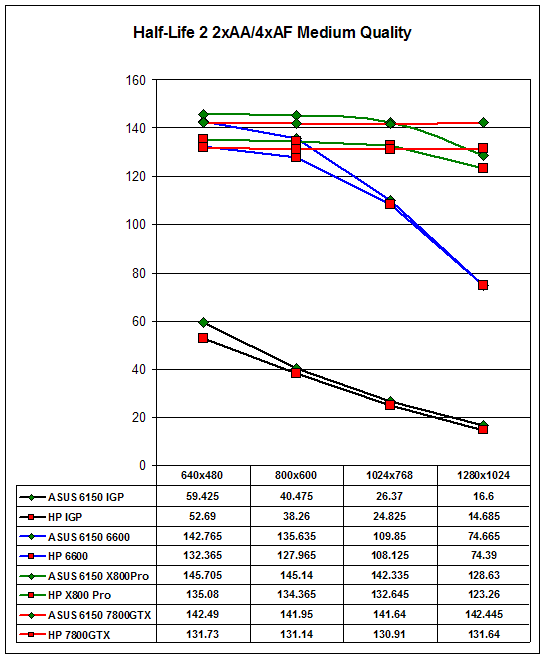
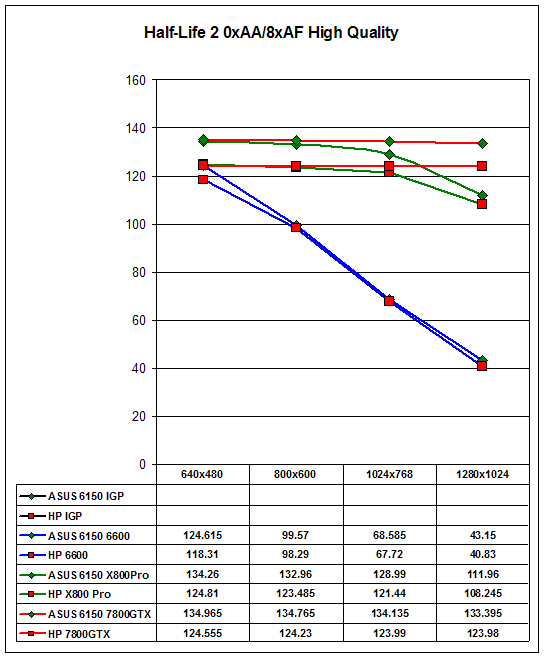
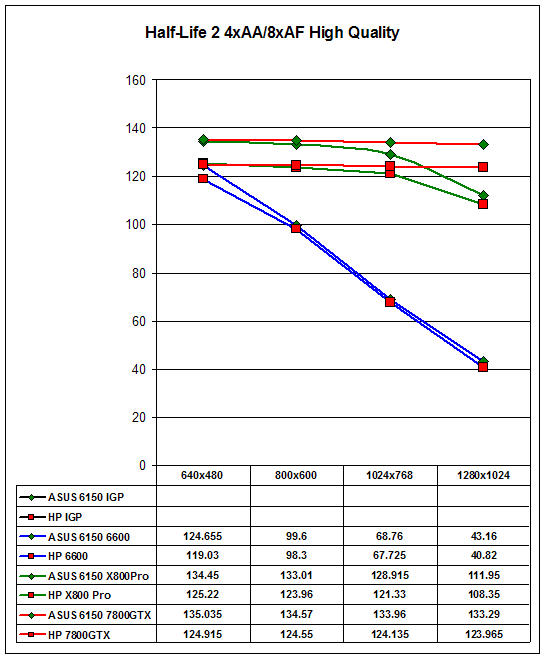
Half-Life 2 depends more on pixel shader performance than it does on GPU bandwidth, so the difference between high quality and low quality settings isn't very pronounced in many of the tests. For the integrated solutions, the 6150 does come out ahead by a decent margin in medium-quality mode, showing the power of its 475 MHz clock speed.
With the discrete graphics cards, notice how there's no difference in performance between the high-quality scores with and without antialiasing - all of the cards are either GPU core limited, or CPU limited. There is a sizable difference when we look at the low-quality scores, but there's really no point in running these cards at the lower quality settings.
Synthetic Benchmarks
We'll wrap up our performance benchmarking with a couple of less important metrics. Futuremark has been making 3DMark for over six years, and many people refer to it to see how a system will perform in games. We have always preferred real world gaming benchmarks, though it's difficult to come up with repeatable tests for certain genres. We also included the memory latency, as measured by CPU-Z.
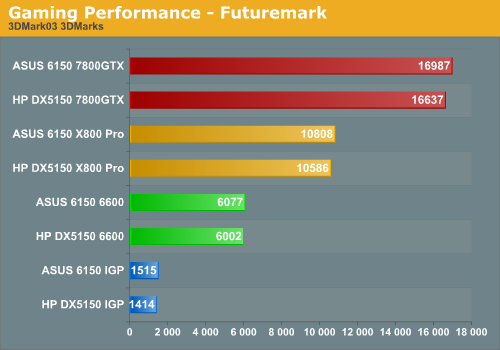
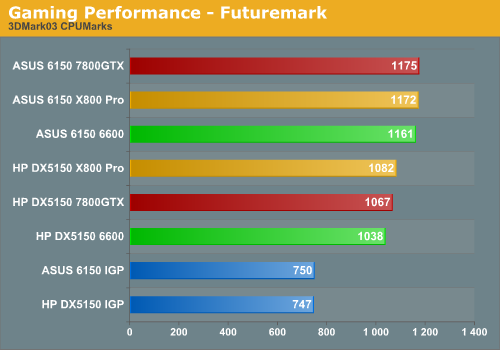


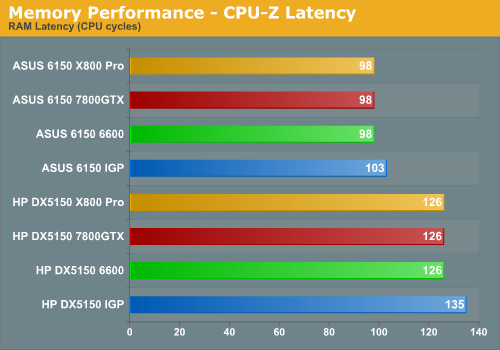
Going along with that last point, take a look at the memory latencies. Since both chips are running at 2.4 GHz, we can directly compare the results without converting to nanoseconds. The HP system with its CL3 RAM ends up having 28% higher latencies, which explains why it consistently gets beat by the ASUS system with the slightly slower processor. Also somewhat interesting is that the IGP solutions both have higher memory latencies, showing that the shared memory architecture does have an impact on performance.
Power Usage and Noise Levels
One item that's almost sure to cause concern among many people is the 250 W power supply in the HP DX5150. We were a bit concerned as well, so we took some readings during testing. You can see the results below.
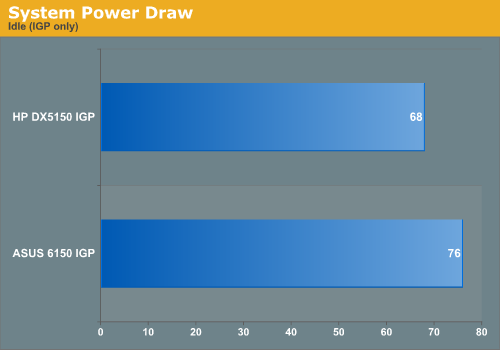
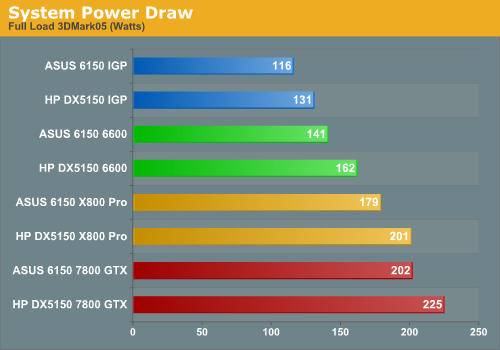
Some PSU manufacturers rate by peak power output, while others rate using sustained power output. Hopefully, this HP power supply is the latter. Despite our concerns, though, the HP system didn't crash once during testing. (Also note that the power draw does not take into account PSU efficiency; the HP PSU is rated to output 250W, so if it's 70% efficient it would draw up to 350W.)
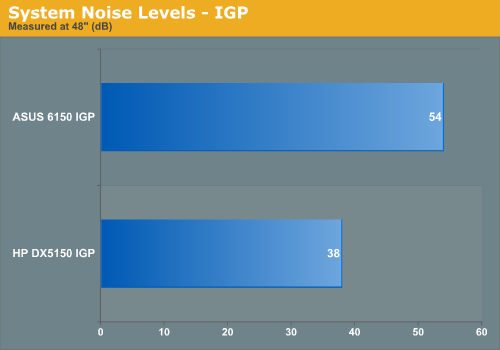
Conclusion
The end result was almost a foregone conclusion. This is a good system, the price isn't bad, and it's extremely easy to set up and use. For a business or home-office user, buying a standard OEM system is a good idea - that's especially true if you're not a computer expert capable of troubleshooting all your hardware and software problems. (The warranty probably doesn't cover software problems, though.) Performance definitely isn't going to match the top enthusiast systems, but for business use, it really doesn't need to.
This system is billed as a small to medium business computer, and it is exactly that. Large businesses and corporations could use it as well, though getting them to switch from Intel is going to take a lot more than just a moderately better price/performance ratio. Corporate computers - at least from Intel - have a guaranteed availability timeframe, on all their parts. We discussed this a couple of months ago in our Intel Corporate roadmap. Basically, Intel has the advantage since they can control all aspects of the core system configuration, from chipset to motherboard to processor.
There's also a question of AMD's ability to supply enough processors to compete in the corporate desktop sector. Intel gives OEMs bulk discounts and incentives, and they can do that because they're manufacturing millions of processors. As much as I like AMD's processors, only having one fabrication facility producing their latest processors limits their ability to compete with Intel, at least for now. I'm sure that HP won't have any difficulty supplying these DX5150 systems to interested companies, but if Intel were to suddenly disappear this instant, AMD would likely be unable to meet the demands of all the OEMs of the world. AMD needs to make inroads over time, increase fabrication capacity, and sell more chips; systems like this HP DX5150 help them do exactly that.
What about home users? The price is attractive, the system looks pretty nice, and the system is also quiet. If you're building a system for a computer neophyte, you might save yourself some tech support headaches by just getting one of these instead. The only thing missing is graphics performance, and if you're interested in playing games, all you need to do is add a good graphics card. At higher resolutions, most of the latest games are still GPU limited, so even though the RAM, motherboard, and processor may not be as fast, the difference is less than 10%. I certainly wouldn't purchase one of the systems for my own use, but then I enjoy tweaking computer hardware to get the most performance possible. Families and casual computer users will probably appreciate the ease of use more than they miss the lost performance and features.
As a final recommendation, we think that many people will get better overall satisfaction out of the DX5150 X2 3800+ Smart Buy. The only drawbacks are that it has a smaller hard drive and it uses a CD-RW/DVD-ROM combo drive in place of the 16X DVDR. Those might be useful upgrades for home users, but most businesses don't need a lot of drive space and a DVD burner on every system. (That system might appear to be a single core 3800+, but we have been informed that SKU PZ635UA# ABA is in fact an X2 3800+ chip.)

